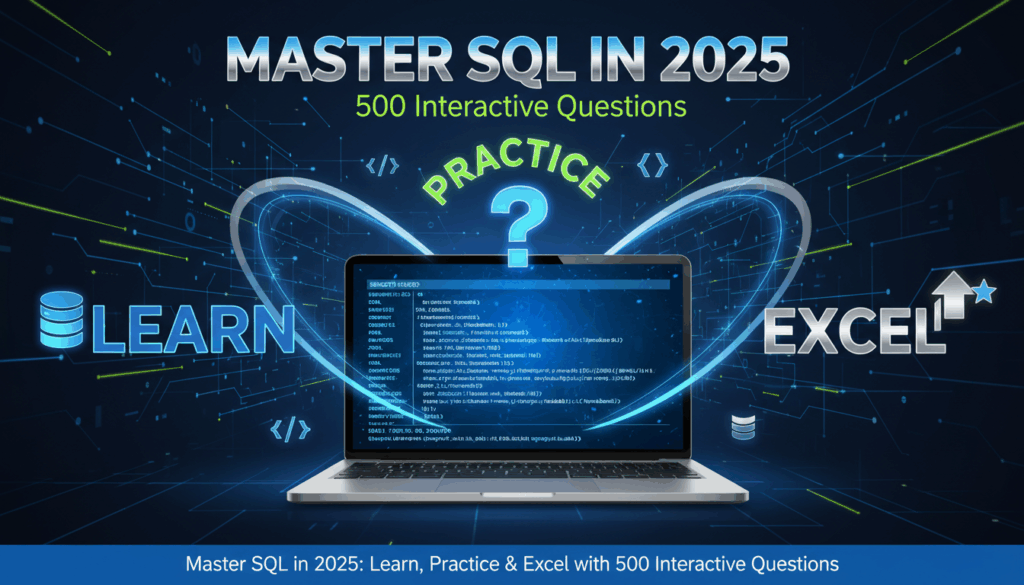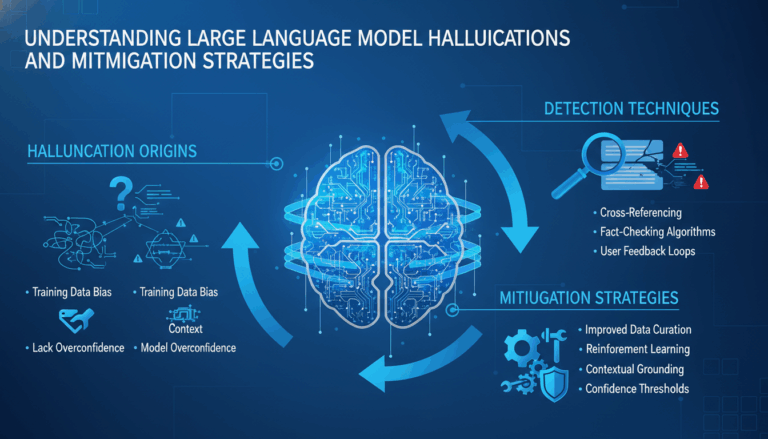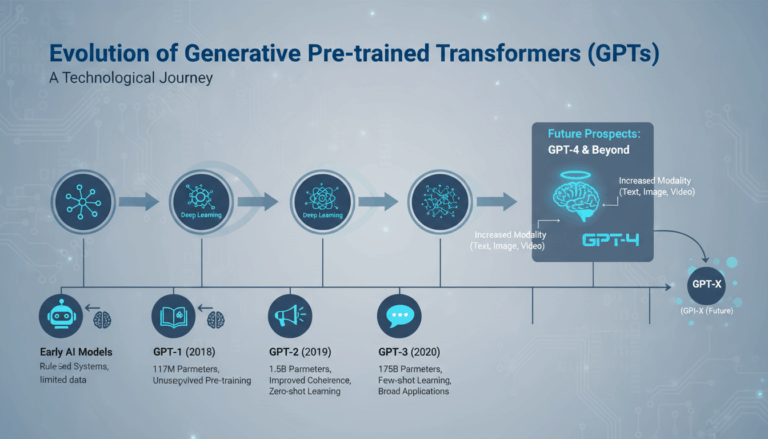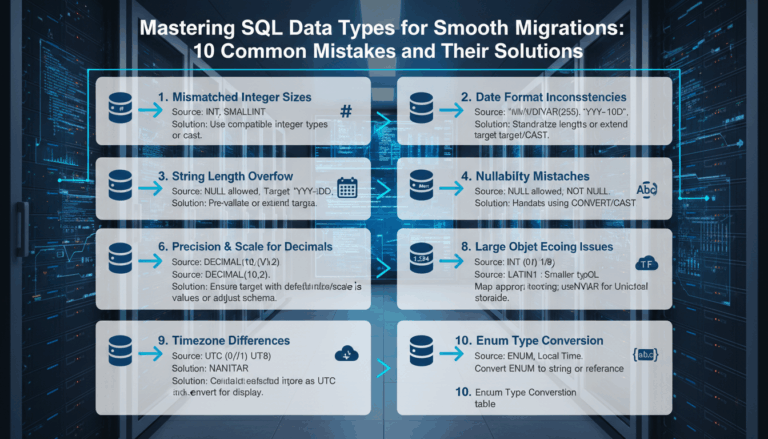Introduction to SQL and Its Importance in 2025
In the contemporary digital landscape of 2025, SQL (Structured Query Language) remains a cornerstone of data management and business intelligence. As organizations continue to generate immense volumes of data—from transactional records to IoT sensor inputs—the ability to efficiently query and manipulate this data has never been more critical.
SQL is the standard language for relational database management systems, used by organizations across various sectors to interface with databases, store, retrieve, and manipulate data. Its pervasive nature means that anyone looking to enter the tech industry, or advance within it, must develop a strong proficiency in SQL.
Pervasiveness of SQL
Despite the advent of NoSQL databases and big data technologies, SQL has maintained its dominance due to its robust framework and wide-ranging support. SQL is compatible with several high-level programming languages and is easily integrated into applications, making it an enduring tool in the developer’s toolkit.
The majority of enterprise database systems—such as Oracle, SQL Server, MySQL, and PostgreSQL—utilize SQL as their primary query language. This universal acceptance means that SQL skills are highly transferable across various systems and applications, providing a flexible foundation for career growth in numerous fields such as data science, software engineering, and business analysis.
The Role of SQL in Modern Data Environments
In 2025, the importance of SQL is highlighted by its integration into cloud-based data platforms and data lakes, which dominate modern IT architectures. Even as organizations adopt hybrid and cloud-based solutions, SQL offers a familiar interface to manage vast data repositories effectively. Services offered by Microsoft Azure, Google Cloud, and Amazon Web Services (AWS) often feature SQL-based components, enabling seamless data querying, analysis, and reporting.
Moreover, SQL has adapted over the years to encompass new functionalities, such as handling JSON data and supporting distributed SQL platforms, which allow for greater scalability and efficiency across distributed databases. SQL’s adaptability ensures it remains relevant in addressing contemporary data challenges.
Enhancing Data Analysis and Business Intelligence
Data-driven decision-making is fundamental in today’s competitive business environment, and SQL is central to this process. By enabling complex queries that aggregate and transform data from multiple sources, SQL empowers professionals to extract meaningful insights. This capability is crucial for developing data-driven strategies, driving productivity, and enhancing customer experiences.
Business intelligence (BI) tools heavily rely on SQL for backend data processing. Tools such as Tableau, Power BI, and Looker often require SQL proficiency to create detailed and interactive reports. Mastering SQL thus equips individuals to leverage these powerful tools effectively, allowing businesses to visualize data and share insights across the organization.
Future-Proofing Your SQL Skills
As the technology landscape continues to evolve, continuously updating one’s SQL skills is necessary to remain competitive. Enhancements in SQL standards and features call for ongoing learning and practice. Engaging with interactive SQL challenges, online courses, and community forums ensures that professionals remain updated with best practices and innovative SQL techniques.
Understanding both foundational and advanced SQL concepts is indispensable for those looking to excel in data-centric roles. Whether through mastering joins, understanding complex query optimization, or learning about interfacing with modern database architectures, SQL’s breadth offers a rich landscape for professional development.
In conclusion, the relevance of SQL in 2025 and beyond is unquestionable. Its enduring presence in data management, business intelligence, and modern analytics platforms underscores the importance of mastering SQL in today’s and tomorrow’s data-driven world.
Setting Up Your SQL Environment: Tools and Resources
In 2025, setting up an effective SQL environment requires understanding the tools and resources available that can improve your productivity, learning, and application of SQL skills. Whether you’re a beginner aiming to start your SQL journey or an experienced professional looking to refine your setup, the choices you make in selecting the right tools can significantly impact your database management efficiency.
Begin by choosing a robust Database Management System (DBMS). Options like MySQL, PostgreSQL, Oracle Database, and Microsoft SQL Server continue to dominate the landscape. Each of these systems has unique strengths:
- MySQL is renowned for its speed and reliability, making it a popular choice for web-based applications.
- PostgreSQL offers advanced features like custom data types and full-text search, delivering high extensibility and standards compliance.
- Oracle Database is designed for enterprise solutions, providing high-level support for complex transactions.
- Microsoft SQL Server is well-integrated with the Microsoft ecosystem, beneficial for users familiar with Windows-based systems.
Next, consider the Integrated Development Environment (IDE) or SQL Editor. These tools enhance coding efficiency and provide powerful debugging capabilities. Some popular choices include:
- DBeaver: A universal database management tool that provides a comprehensive user interface for managing various databases.
- SQL Workbench: Offers a versatile editor with syntax highlighting and smart auto-completion.
- Oracle SQL Developer: Specifically tailored for Oracle, it offers comprehensive development functionalities.
- Datagrip by JetBrains: Recognized for its advanced code refactoring and version control integration.
Ensure you have a reliable version control system in place. Git is the industry standard for tracking changes, facilitating collaboration across development teams, and integrating seamlessly with many SQL environments.
Containerization tools such as Docker can simplify SQL environment setup by providing pre-configured images for many databases. This approach is invaluable for testing various setups efficiently. Docker allows for consistent development and production environments, minimizing “it works on my machine” issues.
For cloud-based development, explore cloud services such as Amazon RDS, Google Cloud SQL, and Microsoft Azure SQL Database. These platforms offer scalable solutions with integrated security and management features, alongside automated backups and patching, enabling you to focus more on development tasks rather than administration.
In 2025, real-time collaboration and remote work are more prevalent. Tools like DataGrip or VS Code’s Live Share extension enable pair programming and collaborative coding, breaking geographical boundaries.
To round out your environment, leverage educational resources and communities for continuous learning and issue resolution. Platforms like Stack Overflow, SQL Server Central, and reddit (r/SQL) provide communities of SQL enthusiasts and experts where you can share, learn, and discuss SQL-related questions and innovations.
By carefully selecting and integrating these tools and resources, you can create a powerful and efficient SQL environment that supports advanced development and enhances your data management capabilities, aligning with modern practices and technologies in 2025.
Fundamental SQL Commands and Syntax
SQL, as the language of databases, serves as the backbone of data manipulation, providing users with the tools to interact seamlessly with large datasets through structured commands and syntax. Mastering the essentials of SQL commands is foundational for any database role, from querying data to altering database structures.
At the core of SQL are four primary types of commands, often remembered by the acronym CRUD: Create, Read, Update, Delete. These are categorized under Data Definition Language (DDL) and Data Manipulation Language (DML). Let’s explore these commands in detail.
Data Definition Language (DDL)
DDL commands are used to define, modify, and remove database objects, such as tables and schemas. These commands dictate the structure and setup of a database.
- CREATE: The
CREATEstatement is used to create a new database or database object (like a table).
sql
CREATE TABLE Employees (
EmployeeID INT PRIMARY KEY,
FirstName VARCHAR(50),
LastName VARCHAR(50),
HireDate DATE
); In this example, CREATE TABLE defines a new table called Employees, specifying columns and their data types.
- ALTER: This command modifies existing database objects, such as adding or dropping columns from a table.
sql
ALTER TABLE Employees
ADD Email VARCHAR(100); This command adds a new column Email to the Employees table.
- DROP: The
DROPcommand is used to delete objects from the database. Be cautious, as this is irreversible.
sql
DROP TABLE Employees; This command deletes the Employees table from the database.
Data Manipulation Language (DML)
DML commands are utilized to retrieve and manipulate data within the database. These commands are crucial for everyday database interaction.
- SELECT: The
SELECTstatement fetches data from a database.
sql
SELECT FirstName, LastName
FROM Employees
WHERE HireDate > '2025-01-01';This query retrieves the first and last names of employees hired after January 1, 2025.
- INSERT: This command adds new records to a table.
sql
INSERT INTO Employees (EmployeeID, FirstName, LastName, HireDate)
VALUES (1, 'John', 'Doe', '2025-01-15'); This inserts a new row into the Employees table.
- UPDATE: The
UPDATEcommand modifies existing data within a table.
sql
UPDATE Employees
SET Email = 'john.doe@example.com'
WHERE EmployeeID = 1; This updates the Email field for the employee with ID 1.
- DELETE: This command removes records from a table.
sql
DELETE FROM Employees
WHERE HireDate < '2020-01-01';This deletes records of employees hired before 2020.
Syntax Essentials
Understanding SQL syntax is critical to writing precise and effective queries:
-
Clauses: These form the backbone of SQL queries. Typical clauses include
SELECT,FROM,WHERE,GROUP BY,ORDER BY, andHAVING. -
Predicates and Operators: Used for specifying conditions (
=,<>,<,>,BETWEEN, etc.). They refine query results and control logic flow within commands. -
Functions: SQL includes numerous functions such as aggregate functions (
SUM(),COUNT(),AVG()) used to calculate summaries of data. -
Joins: Joins are used to combine records from multiple tables. Common joins include INNER JOIN, LEFT JOIN, and RIGHT JOIN.
sql
SELECT Employees.FirstName, Departments.DepartmentName
FROM Employees
INNER JOIN Departments ON Employees.DepartmentID = Departments.DepartmentID;This join fetches employee and department data based on department association.
Mastering these fundamental commands and syntax elements is essential for anyone interacting with databases. They form the basis upon which more advanced SQL skills are built, serving as indispensable tools in data querying and management.
Advanced Query Techniques: Joins, Subqueries, and Window Functions
To maximize the utility of SQL and harness its full power in 2025, a well-rounded understanding of advanced query techniques is essential. This involves mastering joins, subqueries, and window functions, which allow for complex data manipulation and retrieval.
SQL joins are fundamental for combining rows from two or more tables based on related columns. There are several types of joins, each serving unique purposes:
- Inner Join: This returns records that have matching values in both tables. For example, to find employees and their corresponding department names, you would write:
sql
SELECT Employees.FirstName, Departments.DepartmentName
FROM Employees
INNER JOIN Departments ON Employees.DepartmentID = Departments.DepartmentID;This query extracts only the records where there is a match between EmployeeID in the Employees and Departments tables.
- Left Join (or Left Outer Join): This returns all records from the left table (Employees), and the matched records from the right table (Departments). If there is no match, NULL values are returned for columns from the right table.
sql
SELECT Employees.FirstName, Departments.DepartmentName
FROM Employees
LEFT JOIN Departments ON Employees.DepartmentID = Departments.DepartmentID;This query is useful for identifying employees who might not yet be assigned to a department.
-
Right Join (or Right Outer Join): Opposite of a left join, returns all records from the right table and matched records from the left. It can identify departments without any employees assigned.
-
Full Join: Combines the results of both left and right joins, returning all records when there is a match in either table.
Understanding subqueries is another cornerstone of sophisticated SQL query writing. A subquery is a query nested inside a larger query, often used to perform more complex filtering and data segmentation:
- Subqueries in SELECT statements can refine data:
sql
SELECT FirstName, LastName
FROM Employees
WHERE EmployeeID IN (SELECT EmployeeID FROM EmployeeProjects WHERE ProjectID = 1);Here, the subquery retrieves EmployeeID from EmployeeProjects, allowing the main query to fetch names of employees working on a specified project.
- Correlated Subqueries depend on the outer query for their values, executing once for every row processed by the outer query:
sql
SELECT FirstName, LastName
FROM Employees E
WHERE EXISTS (SELECT 1 FROM Departments D WHERE D.ManagerID = E.EmployeeID);This retrieves details of employees who are also department managers, by checking conditions in the correlated subquery.
Window functions represent a more advanced feature, offering powerful analytical capabilities such as ranking, running totals, and moving averages. Unlike aggregate functions, window functions perform calculations across a set of table rows that are somehow related to the current row.
- Using ROW_NUMBER():
sql
SELECT FirstName, LastName, ROW_NUMBER() OVER (PARTITION BY DepartmentID ORDER BY HireDate) as RowNum
FROM Employees;This assigns a unique sequential integer to rows within a partition of a result set.
- RANK() function is used for ranking, similar to ROW_NUMBER(), but can handle tying situations where two values might get the same rank:
sql
SELECT FirstName, Salary, RANK() OVER (ORDER BY Salary DESC) AS SalaryRank
FROM Employees;With the RANK() function, you can see how each employee’s salary stacks up against others.
- SUM() USED AS A WINDOW FUNCTION for cumulative totals:
sql
SELECT FirstName, Salary, SUM(Salary) OVER (ORDER BY EmployeeID ROWS UNBOUNDED PRECEDING) as CumulativeSalary
FROM Employees;This cumulatively adds salary figures in the order of employee IDs.
Mastering these advanced query techniques greatly enhances your SQL capabilities, enabling handling of complex data analysis and retrieval tasks crucial in today’s data-driven decision-making environments.
Interactive Practice: Solving Real-World SQL Problems
One of the most effective ways to reinforce SQL skills is through interactive practice that tackles real-world data situations. This approach not only sharpens problem-solving abilities but also builds confidence in handling actual datasets that one might encounter in professional scenarios.
Imagine a scenario where a retail company wants to analyze customer purchase patterns to optimize inventory management. You’re tasked with extracting meaningful insights from the sales data stored in a SQL database. Here’s how you might approach solving this problem interactively:
Understanding the Dataset
First, ensure you have a clear understanding of the structure and content of your database. Suppose you have tables like Customers, Orders, and Products. Start with:
SELECT * FROM Customers LIMIT 5;
SELECT * FROM Orders LIMIT 5;
SELECT * FROM Products LIMIT 5;
By doing this, you familiarize yourself with the columns and types of data you’ll be working with, such as customer names, order dates, and product details.
Identifying Key Queries
Next, determine the types of queries that will help your analysis. Begin by exploring sales trends over time or identifying frequent buyers:
- Total Sales Over Time:
To examine sales trends, you could use:
sql
SELECT DATE(OrderDate) AS Date, SUM(TotalAmount) AS TotalSales
FROM Orders
GROUP BY Date
ORDER BY Date;This query groups orders by date, allowing you to visualize sales fluctuations.
- Top Customers by Total Purchases:
Identifying key customers can help target marketing efforts:
sql
SELECT C.CustomerID, C.Name, SUM(O.TotalAmount) AS TotalSpent
FROM Customers C
JOIN Orders O ON C.CustomerID = O.CustomerID
GROUP BY C.CustomerID, C.Name
ORDER BY TotalSpent DESC
LIMIT 10;This query involves a join between Customers and Orders to sum up the total amounts spent by each customer.
Incorporating Complex Analyses
More complex scenarios might require a deeper dive using advanced SQL features like subqueries and window functions:
- Locate Most Popular Products:
To determine which products are top sellers:
sql
SELECT P.ProductID, P.ProductName, COUNT(O.ProductID) AS NumberSold
FROM Products P
INNER JOIN Orders O ON P.ProductID = O.ProductID
GROUP BY P.ProductID, P.ProductName
ORDER BY NumberSold DESC;This query uses an inner join to count the number of orders per product.
- Customer Order Frequency:
Employ window functions to find customers who order frequently:
sql
SELECT CustomerID, OrderDate,
COUNT(OrderID) OVER (PARTITION BY CustomerID ORDER BY OrderDate) AS OrderFrequency
FROM Orders;This query calculates the number of orders made by each customer over time, providing insight into buying patterns.
Interactive Debugging and Optimization
While practicing, you might want to optimize queries for performance. Utilize the EXPLAIN statement to diagnose how SQL queries execute:
EXPLAIN SELECT * FROM Orders WHERE OrderDate > '2025-01-01';
This output reveals how MySQL (or other SQL engines) processes your query, helping you adjust for speed and efficiency.
Practical Implementation
Integrate SQL exercises into your routine on platforms like SQLZoo or LeetCode where real-world datasets are used for hands-on practice. Adjust problems to mimic realistic situations such as evaluating financial metrics or navigating complex joins and conditions.
Interactive SQL practices designed around real-world problems enhance your problem-solving agility and readiness for professional challenges, ensuring you are not merely familiar with SQL syntax but proficient in applying it effectively.
Preparing for SQL Interviews: Common Questions and Best Practices
SQL interviews challenge candidates on their ability to navigate databases and interrogate data efficiently using SQL. Preparation involves familiarizing oneself with common question patterns and best practices essential to acing these interviews.
Interviews often test a candidate’s understanding of core SQL concepts and the ability to apply them to solve practical problems. A common question involves writing queries to select specific data, manipulate datasets, or design schema objects.
Common Questions
- Basic Queries
Interviewers may start with queries that test understanding of basic SQL syntax and commands. Candidates might be asked to use SELECT, INSERT, UPDATE, and DELETE statements efficiently.
- Example: Retrieve a list of employees who joined after a specific date.
sql SELECT FirstName, LastName FROM Employees WHERE HireDate > '2025-01-01'; - Task: Modify this query to include departments.
- Joins and Subqueries
Understanding different types of joins (INNER, LEFT, RIGHT, FULL) and implementing subqueries is crucial. Questions might require you to join tables based on certain conditions or use subqueries to refine data retrieval.
- Example: Fetch department names along with the total salaries in each department.
sql SELECT D.DepartmentName, SUM(E.Salary) AS TotalSalaries FROM Employees E INNER JOIN Departments D ON E.DepartmentID = D.DepartmentID GROUP BY D.DepartmentName; - Challenge: How would you handle departments with no employees?
- Complex Aggregations
SQL interviews frequently involve questions about aggregating data with GROUP BY, HAVING, and using functions like SUM(), AVG(), and COUNT().
- Example: Calculate the average salary per department, excluding departments with fewer than 5 employees.
sql SELECT D.DepartmentName, AVG(E.Salary) AS AvgSalary FROM Employees E JOIN Departments D ON E.DepartmentID = D.DepartmentID GROUP BY D.DepartmentName HAVING COUNT(E.EmployeeID) >= 5; - Focus: Ensure your query optimizes performance across large datasets.
- Schema Design and Normalization
New roles may require you to evaluate and design database schemas. Considerations include normalization to eliminate redundancy and update anomalies.
- Scenario: Explain how to refactor an employee database to achieve third normal form (3NF).
Best Practices
-
Start with Simplified Queries: Break down complex queries. Decompose them into smaller parts and test incrementally.
-
Optimize Query Performance: Use
EXPLAINto understand query execution plans. This helps in optimizing joins and index usage. -
Understand Business Context: Relate SQL problems to real business scenarios. This contextual understanding enables you to propose practical and efficient solutions.
-
Practice on Variety of Platforms: Use coding platforms like LeetCode or HackerRank to simulate interview conditions. Practicing under time constraints aids readiness.
-
Engage with Community: Discuss SQL problems on forums like Stack Overflow or participate in SQL-centric meetups. Peer discussions often yield insights into diverse approaches to problem-solving.
Mastering these areas not only prepares you for SQL interviews but also establishes a robust foundation for tackling real-world data challenges. By systematically honing your skills through practice and active engagement with SQL communities, you ensure readiness for a wide range of SQL interview scenarios.




